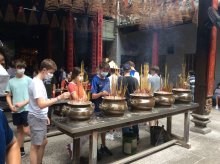
by Alice Clarke, Year 11
Over October half term History pupils in Years 10-13 were given the opportunity to spend 9 days in Vietnam, learning about the country, both its history and its culture. It was a thoroughly enriching experience that I cannot recommend enough to anyone wishing to go on the next incarnation this trip takes.
Personally, it was an extremely memorable experience for a variety of reasons. It has stood me in exceedingly good stead for all future learning regarding the Cold War, American foreign intervention, colonialism (French and otherwise), Southeast Asian politics and much, much more. It has provided me with a rich ground layer of context on which to base my understanding, and besides that was thoroughly enjoyable too. The trip began with our arrival in Hanoi where we met our guide who would be with us until we left the north, who introduced himself as Nguyen. We received an introduction to Hanoi and were served a local snack - rice crackers and dried jackfruit. We first visited the Temple of Literature, an ancient university that accepts the three best students from the entire country each year and keeps a record of each graduation on historical stone stelae. Here we learned a few key throughlines and customs that would stay constant throughout- every temple and pagoda we visited had three gateways - one large, for high-status individuals, and two smaller, for the rest of us. Needless to say, we were always taking the smaller sets. Each temple also had raised thresholds that we were expected to step clean over, keeping out bad spirits.
We had dinner at a local restaurant, named Know One Teach One, that used its profits to help disadvantaged individuals and communities, and provide education. We topped off the day with a rickshaw tour of the city centre that came with several near misses with passing traffic for everyone involved. After a visit to “Tortoise Pagoda,” we ended our first day, thoroughly exhausted.
Day 2 began with an early breakfast at 06:30, and we checked out of our hotel baggage in. We were all living out of our suitcases for the week, not staying more than two nights anywhere, and this was an adjustment that came easier to some than to others! Plenty of bleary eyes and disarrayed luggage could be seen on any morning you might choose. But no suitcases were lost in the making of this school trip.
A visit to the Ho Chi Minh mausoleum came next, situated opposite the parliament building, giving us a chance to admire the contrast between the surrounding French colonial architecture that formed the bones of the city, and the newer Soviet brutalist architecture that symbolised the shift in trajectory this country had taken. Although we could not see the body of Vietnam’s most admired freedom fighter/dictator, after whom the former capital of Saigon was renamed, as he was away on maintenance, Nguyen took the chance to explain how Vietnam's political system worked: there is only one party, the Communists, but they still hold elections every four years, “just for fun.” We also visited the iconic “One Pillar Pagoda,” preserved despite the ever-growing city, and were taught the intricacies of Vietnamese bonsai growing practices. Although a staple of western perceptions of Asia, there is massive variation in the species, aims and purposes of bonsai grown in each country, and each region of each country. Nguyen explained to us that bonsai in Vietnam are usually symbolic, and often commemorative, of personal relationship, or figure. Two trees of equal height indicate siblings, one slightly shorter equals friends, and a smaller one sheltered by a larger one indicates a maternal or paternal relationship. Gender is indicated by the slope of the trees, and a mother is always covering more of a “child” offshoot more than a father would. We then left Hanoi for Halong Bay, which promised to be one of the highlights of our stay. We saw local Vietnamese people going about their day-to-day life, facilitated by the considerable number of motorcycles and mopeds that crowded the roads of Hanoi.
When we arrived in Halong Bay we boarded a boat for a tour of the bay. A wide variety of cuisine was served for lunch, and the quality of food remained excellent throughout our stay. As night fell, some of us chose to partake in the night-time squid fishing, while others stayed on deck and admired the limestone rocks jutting from the emerald sea, but one thing not advertised on the itinerary was the phenomenal singing skills demonstrated by every member of staff through the medium of karaoke. My compliments and thanks again to Mr Lemieux, Mr Milford, Miss Jones, and Mrs Niel, not only for their dedication and ceaseless effort in ensuring the success of the trip, but also for providing everyone with what was uncontestably the best night of entertainment experienced by anyone for the duration of the trip.
 For those up early on Day 4, sunrise Tai Chi was available presented by a member of the cooking staff in silk robes and Nike shoes. After a colourful brunch, we stopped off at a few key locations on our bay tour - a lovely kayak rental space surrounded by serene, sheer slopes that was enjoyed by all, and an aptly named “Shining Grotto”, a set of caves full of gorgeous stalactites and stalagmites that stayed lodged in the minds of all involved. Unfortunately, that stage of the trip had ended, and at the end of the day, we departed by an internal flight for Ho Chi Minh City, the city formerly known as Saigon. Our guide, Mr Quang, introduced us to the city in a similar manner as Nguyen (whom we had just said our goodbyes to) had with Hanoi, followed by a buffet dinner that included in its selection delicacies such as jellyfish, embryo eggs (fertilised chicken eggs where the foetus was already developing), and much more. Perhaps it will not surprise you to know that much of our contingent was fuelled almost exclusively by the bog-standard chips that also happened to be served.
For those up early on Day 4, sunrise Tai Chi was available presented by a member of the cooking staff in silk robes and Nike shoes. After a colourful brunch, we stopped off at a few key locations on our bay tour - a lovely kayak rental space surrounded by serene, sheer slopes that was enjoyed by all, and an aptly named “Shining Grotto”, a set of caves full of gorgeous stalactites and stalagmites that stayed lodged in the minds of all involved. Unfortunately, that stage of the trip had ended, and at the end of the day, we departed by an internal flight for Ho Chi Minh City, the city formerly known as Saigon. Our guide, Mr Quang, introduced us to the city in a similar manner as Nguyen (whom we had just said our goodbyes to) had with Hanoi, followed by a buffet dinner that included in its selection delicacies such as jellyfish, embryo eggs (fertilised chicken eggs where the foetus was already developing), and much more. Perhaps it will not surprise you to know that much of our contingent was fuelled almost exclusively by the bog-standard chips that also happened to be served.
Day 5 kicked off with a visit to a crowded local market where we split into groups and all assigned chefs who talked us through Vietnamese food, its ingredients, and their uses. We selected the ingredients we would need for our upcoming cookery classes, as well as plenty of souvenirs to take back home. The price paid for the latter depended greatly on how good you were at disguising how much of a clueless tourist you were, your confidence, and your willingness to simply walk away from any stall - a tactic that seemed to magically decrease the absolute minimum the stallholders were willing to pay by a margin of about 60%. Among the items available was a variation of English and American brands, with varying degrees of authenticity. A personal favourite of many people was a prominently displayed t-shirt that loudly proclaimed to have been manufactured by The North Face, with the usual divided quarter circle logo accompanying each word, with a fourth, earnest strip of embroidery that read “Gucci” in the same typeface and styling, as if said t-shirt was in the throes of an identity crisis. Following this excursion, lunch was left up to us! In a frenetic, timed, competition to prepare and display a set of traditional dishes, we were instructed by trained chefs in creating our own meal for the day, with prizes being handed out to the group who had the least mixed success. After this, we visited the War Remnants Museum (formerly the Exhibition House of American War crimes), which was full to bursting with primary sources that proved invaluable for the A Level students tackling their coursework on the Vietnam War. It was also an excellent lesson in how evidence can be presented to form a biased standpoint, and how to adjust for that while still considering the validity of the sources presented.
After a thoroughly enlightening experience, we took a tour around Dong Khoi Street, admiring the colonial architecture of the Opera House, Post Office, Notre Dame replica cathedral, colonial hotel and more. We also caught a glimpse of the infamous ex-CIA building, the site of the “last chopper out of Saigon” photo. We finished the day with a traditional water puppet show, accompanied by incredibly skilled musicians, and after heading for dinner we turned in for the night. The sixth day of our visit began with a visit to the “Reunification Hall,” the former presidential palace, where we saw where the South Vietnamese and American generals had made military decisions and the bunkers they stayed in while the building itself was under threat. This was a great opportunity to further our knowledge about the war and the contemporary response of the locals, and many questions were asked of Quang, who remained our guide. We visited a traditional Taoist temple and lit incense, while observing many residents of the city come in to offer prayers. While most of the population is Buddhist, there is a great deal of variety when it comes to religion in Vietnam, and it is a heavily politicised issue. Much was learned of the different sects within Buddhism, and Quang had quite a bit to say on this topic, as he often did.
 We then travelled to the Mekong Delta, a far more rural place, where we checked in at a riverside resort by boat and enjoyed the facilities made available to us. Lunch was included at a local restaurant, which included a whole fish, fried in rice, for all the non-vegetarians. Again, it will perhaps not surprise you to know that much of this, despite all the prodding, was left uneaten. On the penultimate day we were rowed through a local farming community in small boats known as sampans, an experience that culminated in a performance of traditional music by a small band and two singers. Quang translated the narratives and gave cultural context to each performance, which explored themes of tragedy, love, loss, and separation. We also visited a family-run business making rice paste, coconut candy and popped rice, got thoroughly rained on in a way that can only happen in the tropics, and capped off the day with an exhilarating “dinner in the dark”, where we could not see what we were eating and were served by waitressing staff that, in the light areas, were deaf, and in the dark ones, were blind! We were all shown what we had been eating after the event, and while nothing too outlandish had been slipped onto our plates, there were many cries of surprise, but also those of satisfaction, as an astute guess was confirmed.
We then travelled to the Mekong Delta, a far more rural place, where we checked in at a riverside resort by boat and enjoyed the facilities made available to us. Lunch was included at a local restaurant, which included a whole fish, fried in rice, for all the non-vegetarians. Again, it will perhaps not surprise you to know that much of this, despite all the prodding, was left uneaten. On the penultimate day we were rowed through a local farming community in small boats known as sampans, an experience that culminated in a performance of traditional music by a small band and two singers. Quang translated the narratives and gave cultural context to each performance, which explored themes of tragedy, love, loss, and separation. We also visited a family-run business making rice paste, coconut candy and popped rice, got thoroughly rained on in a way that can only happen in the tropics, and capped off the day with an exhilarating “dinner in the dark”, where we could not see what we were eating and were served by waitressing staff that, in the light areas, were deaf, and in the dark ones, were blind! We were all shown what we had been eating after the event, and while nothing too outlandish had been slipped onto our plates, there were many cries of surprise, but also those of satisfaction, as an astute guess was confirmed.
The next day was largely consumed by travel, although we did not get another chance to visit the market. We did though get a good look at the Cu Chi tunnels and surrounding area, which gave us a great insight into how the Viet Cong guerrillas lived and fought, and how they were able to fight off the Americans. When we disembarked from the plane on the 5th of November, sunburned, bedraggled, and thoroughly exhausted, the triumphant return was made all the sweeter by the realisation, and immediate use, of the fact that we could drink out of the taps again. I think all of us were glad to be back, but not one of us was not also glad we went: it was an unforgettable experience that taught us much, stretched us outside our comfort zones and was, all in all, great fun.















.png&command_2=resize&height_2=85)







.png&command_2=resize&height_2=85)
.png&command_2=resize&height_2=85)





